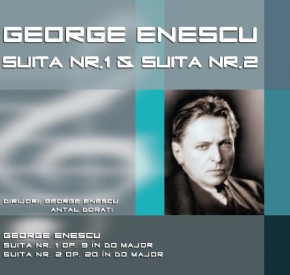NOUTĂȚI
George Enescu – Suitele 1 & 2
Suita nr.1 pentru orchestră, Op. 9 – Orchestra Simfonică din Bucureşti – Dirijor: George Enescu
Suita nr.2 pentru orchestră, Op. 20 – Orchestra Filarmonică „George Enescu” – Dirijor: Antal Doráti
Suita I pentru orchestră opus 9, în Do Major s-a bucurat, chiar de la prima audiţie europeană, de numeroase aprecieri. Şi Preludiul la unison a devenit celebru. … Câtă simplitate, atâta fineţe a demersului în Menuet-ul lent, cu reverberaţii de doină în elegante veşminte polifonice! Iar după un Intermediu contemplativ şi grav, al cărui caracter solemn pare să-i confere o stranie independenţă, această a treia secţiune a suitei fiind omisă mai mult sau mai puţin justificat în anumite restituiri ”live”, mişcarea a patra, purtând ca indicaţie energizantul Vif aduce cu sine un altfel de ambient, întruchipându-se parcă într-o “tarantelă bizară”, după cum a fost uneori caracterizată. …
În 1915, a apărut Suita a II-a pentru orchestră … O altă atitudine estetică, o altă viziune creatoare, dezvăluită de George Enescu însuşi, într-o conferinţă de presă ţinută în capitala Franţei: “…concepută în stil clasic, utilizând o tehnică mai nouă fără a merge totuşi prea departe în îndrăzneală. Atmosfera este poate mai apropiată de ţara mea, România”. Astfel şi-a descris maestrul suita opus 20 alcătuită din şase părţi: impunătoarea Uvertură, în spiritul bachian al unei duble fugi; nostalgica Sarabanda; Giga, de-a dreptul reconfortantă prin antrenantele configuraţii ritmice; tensionatul şi solemnul Menuet grav urmat de Aria, cu rezonanţa intonaţională, lirismul şi asimetria proprii stilului doinit şi Bourrée- ul, ca o replică a primei secvenţe a lucrării, la fel de complexă în privinţa travaliului, prin tratamentul polifonic administrat rondo-ului ca formă de concretizare arhitecturală…
– Mirela Stoenescu– (extras)
The stylistic elements of the classical-romantic music tied to the quasi-folkloric melodic inflections confer to Enescu‘s style of his first creation period an absolute personal, peculiar note. The folk songs and dances heard in his childhood and kept in his memory, appear in a styled form in Suite No. 1 for Orchestra (1903). The presence of some folklore melodic inflexions in the first part of the Suite, in the Prelude a I’unisson, confer it an obvious Romanian flavor. The second Suite’s movement, Menuet lent is in fact a sequel of the first movement because of the frequent appearances of some Prelude‘s motives. The warm lyricism is also proper to the III-th Suite’s movement, interlude, but the atmosphere becomes more tormenting, emotional substance more shady towards the precedent movements. The Finale contrasts emotionally with meditative substance of the precedent movement. Finale with its lively movement could be placed, as for its charm’ between a Gigue and a Tarantella. At the beginning, the dance a sole motive of two bars is predominant and serves in the course of time as a sonorous support to new theme’s superposition. The median part, extreme bright, contributes to the charm of these thrilling Fins.
The Suite No. 2 (also in C Major like the Suite No. 1) has six movements: Ouverture, Sarabande, Gigue, Menuet grave, Aria and Bourrée. It was composed in 1915 and had its first public performance in Bucharest, the 5-th of November 1916, under George Enescu‘s direction. Enescu kept the general character of these ancient dances but adorned the music with a new emotional substance, rich and varied, a contemporary note. While the first movement of the I-st Suite (No. 1) shows Enescu’s style, the same movement of the second Suite shows his exceptional polyphonically mastership. Conceived in a fugue form (here and there on six voices), with two themes, as savant the Overture is built, as is it also expressive; it can be regarded as homage to J.S. Bach, the greatest master of the polyphony. In this rigorous form which presents, in turn, at each one of the superposed voices, the two musical basic ideas of the fugue named expositions – appearing in different tonalities –, bound together by divertimenti (interludes), Enescu employs with a sovereign mastery all the polyphonic artifices for intensifying and enhancing the expression.

